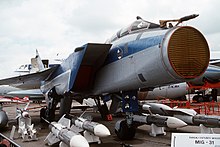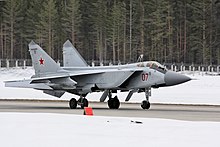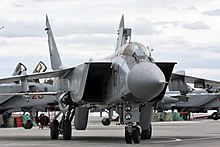From Wikipedia, the free encyclopedia
For the fictional aircraft of the novel and movie Firefox, see Mikoyan MiG-31 (fictional).
| MiG-31 | |
|---|---|
| Russian Air Force MiG-31 in flight | |
| Role | Interceptor aircraft |
| Manufacturer | Mikoyan |
| First flight | 16 September 1975 |
| Introduction | 6 May 1981 |
| Status | In service |
| Primary users | Russian Air Force Kazakhstan Air Force |
| Number built | approx. 400[1] |
| Developed from | Mikoyan-Gurevich MiG-25 |
Contents
Development
The MiG-25, despite Western panic about its tremendous performance, made substantial design sacrifices in capability for the sake of achieving high speed, altitude, and rate of climb. It lacked maneuverability at interception speeds and was difficult to fly at low altitudes. The MiG-25's speed was limited to Mach 2.83 in operations, but it could reach a maximum speed of Mach 3.2 or more with the risk of damaging the engines beyond repair.[3][4]Development of the MiG-25's replacement began with the Ye-155MP (Russian: Е-155МП) prototype which first flew on 16 September 1975.[5] Although it bore a superficial resemblance to a stretched MiG-25 with a longer fuselage for the radar operator cockpit, it was in many respects a new design. The MiG-25 used 80% nickel steel in its structure to allow welding.[6]
The most important development was introducing an advanced radar capable of both look-up and look-down engagement (locating targets above and below the aircraft), as well as multiple target tracking. This finally gave the Soviets an interceptor able to engage the most likely Western intruders at long range.[citation needed]
Like its MiG-25 predecessor, the MiG-31 was surrounded by early speculation and misinformation concerning its design and abilities. The West learned of the new interceptor from Lieutenant Viktor Belenko, a pilot who defected to Japan in 1976 with his MiG-25P. Belenko described an upcoming "Super Foxbat" with two seats and an ability to intercept cruise missiles. According to his testimony, the new interceptor was to have air intakes similar to the Mikoyan-Gurevich MiG-23, which the MiG-31 does not have, at least not in production variants.[citation needed]
Series production of the MiG-31 began in 1979 and about 400 were produced by 2000.[1]
Some upgrade programs have found their way in the MiG-31 fleet, like the MiG-31BM multirole version with upgraded avionics, new multimode radar, hands-on-throttle-and-stick (HOTAS) controls, liquid crystal (LCD) color multi-function displays (MFDs), ability to carry the Vympel R-77 missile and various Russian air-to-ground missiles (AGMs) such as the Kh-31 anti-radiation missile (ARM), a new and more powerful computer, and digital data links.[7] A project to upgrade the Russian MiG-31 fleet to the MiG-31BM standard was begun in 2010;[8] 60 or more aircraft are to be upgraded to MiG-31BM standard by 2020.[9]
Replacement
Russia hopes to field a replacement for the MiG-31 by 2020, with all aircraft retired by 2028. Development of a new aircraft has begun. Development of a new interceptor is favored over restarting MiG-31 production.[10]Design
Like the MiG-25, MiG-31 is a large twin-engine aircraft with side-mounted air intakes, a shoulder-mounted wing with an aspect ratio of 2.94, and twin vertical tailfins. Unlike the MiG-25, it has two seats, with the rear occupied by a dedicated weapon systems officer.[citation needed]Airframe and engines
The wings and airframe of the MiG-31 are stronger than those of the MiG-25, permitting supersonic flight at low altitudes. Its D30-F6 jet engines, each rated at 152 kN thrust, allow a maximum speed of Mach 1.23 at low altitude. High-altitude speed is temperature-redlined to Mach 2.83—the thrust-to-drag ratio is sufficient for speeds in excess of Mach 3, but such speeds pose unacceptable hazards to engine and airframe life in routine use.[3]MiG-31 is limited to only 5 g at supersonic speeds.[3] At combat weight, its wing loading is marginal and its thrust to weight ratio is favorable. However, it is not designed for close combat or rapid turning.[3]
Electronics suite
The MiG-31 was the world's first operational fighter with a passive electronically scanned array radar (PESA), the Zaslon S-800. Its maximum range against fighter-sized targets is approximately 200 km (125 mi), and it can track up to 10 targets and simultaneously attack four of them with its Vympel R-33 missiles. It is claimed to have limited astern coverage, possibly due to drag chute housing above and between the engines. The radar is matched with an infrared search and tracking (IRST) system in a retractable undernose fairing.[3]Radars
Adopted in 1981- the range detection of air targets: 200 km (for the purpose of with the radar cross-section of 19 m² on a collision angles with probability 0.5)
- target detection distance with radar cross-section of 3 m² in the rear within 35 km with a probability of 0.5 ([11][12])
- number of detected targets: 24
- the number of targets for attack: 8
- the range of automatic tracking: 120 km
- detection of thermal goals - 56 km
The onboard radar complex MiG-31БМ is capable of simultaneously detecting 24 air targets, 8 of which can be simultaneously attacked by missiles R-33S. Achieved a possibility to intercept targets flying at a speed corresponding to M=6, improved other characteristics of the complex.[citation needed]
Modernized variants of the aircraft can be equipped with radar missiles Kh-31S, Kh-25MP or Kh-25МПУ (up to six units), anti-ship UR Kh-31A (up to six), class missiles air-to-surface Kh-29 and Kh-59 (up to three) or X-59M (up to two units), up to six corrected air bombs KAB-1500 or eight KAB-500 with television or laser-guided. Maximum mass of payload is to 9000 kg.[citation needed]
The MiG-31M-, MiG-31D-, and MiG-31BS-standard aircraft have an upgraded Zaslon-M radar, with larger antenna and greater detection range (said to be 400 km (250 mi) against AWACS-size targets) and the ability to attack multiple targets — air and ground — simultaneously. The Zaslon-M has a 1.4m diameter (larger) antenna, 50% to 100% better performance than Zaslon. In April 1994 it was used with an R-37 to hit a target at 300 km distance.[citation needed] It has a search range 400 km versus a 19/20 sq m RCS target and can track 24 targets at once, engaging six[14][15](282 km for 5m2[16]).
Cockpit
The aircraft is a two-seater with the rear seat occupant controlling the radar. Although cockpit controls are duplicated across cockpits, it is normal for the aircraft to be flown only from the front seat. The pilot flies the aircraft by means of a centre stick and left hand throttles. The rear cockpit has only two small vision ports on the sides of the canopy. It is argued that the presence of the WSO (Weapon Systems Operator) in the rear cockpit improves aircraft effectiveness since the WSO is entirely dedicated to radar operations and weapons deployment. This decreases the workload of the pilot and increases efficiency. Both cockpits are fitted with zero/zero ejection seats which allow the crew to eject at any altitude and airspeed.[3]It has been claimed by Russian Federation Defence Ministry chief Colonel Yuri Balyko, that the upgrade will increase the combat effectiveness of the aircraft several times over.[17]
Armament
Unlike the MiG-25, the MiG-31 has an internal cannon, a six-barrel, 23 mm GSh-6-23 with 800 rounds of ammunition, mounted above the starboard main landing gear bay. The GSh-6-23 has a claimed rate of fire of over 10,000 rounds per minute. However, after two Su-24 were lost because of premature shell detonation in 1983, plus some different problems with gun usage (system failures, etc.), usage of the GSh-6-23 was stopped by a decision of the Soviet AF Command. The aircraft in the Russian AF were flying with fully operational guns, but without ammunition in January 2009.[18]
Operational history
With the designation Ye-266, a re-engined Ye-155 shattered world records. It reached an absolute maximum altitude of 123,524 ft, or 37,650 m, and set a time to height record of 35,000 m in 4 minutes, 11.78 seconds, both which were set by test pilot Alexander Fedotov. Ostapenko, his deputy, set a record of 30,000 m in 3 minutes, 9.8 seconds.[19]
Following the collapse of the USSR in 1991, however, the budget for spares (MIG-31 AOG desk was created to solve this problem) and maintenance collapsed, leaving many squadrons unable to maintain their complex aircraft.[citation needed]
Approximately 370 are in Russian service, with another 30 or so in Kazakhstan.[20]
Export
Syria ordered eight MiG-31E aircraft in 2007 for Syrian Air Force.[21][22] However, the order has been suspended in May 2009 reportedly either due to Israeli pressure or lack of Syrian funds.[23]Variants
A new version of the MiG-31 with upgraded avionics, the MiG-31B, was introduced in 1990. Its development was the result of the Soviet discovery that Phazotron radar division engineer Adolf Tolkachev had sold information on advanced radars to the West. Tolkachev was executed, and a new version of the compromised radar was hastily developed. Many earlier MiG-31s were upgraded to the new standard, designated MiG-31BM.[24]Development of a more comprehensive advanced version, the MiG-31M, began in 1983 and first flew in 1986, but the dissolution of the Soviet Union prevented it from entering full production.[citation needed] The MiG-31M standard adds some additional features like Global Positioning System (GPS) and GLONASS receivers, and three color CRT MFDs in the rear cockpit.[citation needed]
Notable accidents
On 6 September 2011, a MiG-31 crashed near Bolgary village, Perm region, Russia.[25] The aircraft crashed shortly after takeoff, killing both pilots. Another, non-fatal crash occurred in 2010. The entire fleet was grounded pending an investigation.[26]During the night of 23 April 2013, a Kazakhstan Air Force MiG-31 crashed during a training flight near the village of Prostornoye in the Karaganda Region of Kazakhstan, killing the pilot and injuring the navigator. The plane crashed due to technical failure. The same plane underwent a major overhaul at a plant in Rzhev, northwest Russia in December 2012.[27]
Operators
- Current operators
 Kazakhstan
Kazakhstan
- Kazakhstan Air Force 29 in service[28]
- Russian Air Force 252 in service.[29] 122 active.[10]
- Russian Naval Aviation 30
Former operators
- Soviet Air Defense Forces
- Soviet Air Force aircraft passed on to Russia and Kazakhstan in 1991.
Specifications (MiG-31)
- Crew: Two (pilot and weapons system officer)
- Length: 22.69 m (74 ft 5 in)
- Wingspan: 13.46 m (44 ft 2 in)
- Height: 6.15 m (20 ft 2 in)
- Wing area: 61.6 m² (663 ft²)
- Empty weight: 21,820 kg (48,100 lb)
- Loaded weight: 41,000 kg (90,400 lb)
- Max. takeoff weight: 46,200 kg (101,900 lb)
- Powerplant: 2 × Soloviev D-30F6 afterburning turbofans
- Dry thrust: 93 kN (20,900 lbf) each
- Thrust with afterburner: 152 kN (34,172 lbf) each
- Maximum speed:
- High altitude: Mach 2.83 (3,000 km/h, 1,860 mph)[3]
- Low altitude: Mach 1.2 (1,500 km/h, 930 mph)
- Combat radius: 1,450 km (900 mi)at Mach 0.8/ 720 km (447 mi) at Mach 2.35[31]
- Ferry range: 3,300 km(2,050 mi)
- Service ceiling: 20,600 m (67,600 ft)
- Rate of climb: 208 m/s (41,000 ft/min)
- Wing loading: 665 kg/m² (136 lb/ft²)
- Thrust/weight: 0.85
- Maximum g-load: 5 g
- 1× GSh-6-23 23 mm cannon with 260 rounds.
- Fuselage recesses for 4× R-33 (AA-9 'Amos') (or for MiG-31M/BM only 6× R-37 (AA-X-13 'Arrow') long-range air-to-air missiles)
- 4 underwing pylons for a combination of:
- 2× R-40TD1 (AA-6 'Acrid') medium-range missiles, and[clarification needed]
- 4× R-60 (AA-8 'Aphid')
- 4× R-73 (AA-11 'Archer') short-range IR missiles,
- 4× R-77 (AA-12 'Adder') medium-range missiles.
- Some aircraft are equipped to launch the Kh-31P (AS-17 'Krypton') and Kh-58 (AS-11 'Kilter') anti-radiation missiles in the suppression of enemy air defenses (SEAD) role.
See also
- Firefox (novel) and Firefox (film), the premise of which is the theft of a speculated/fictional version of the MiG-31
- Related development
- Aircraft of comparable role, configuration and era
- Related lists
“This aircraft will be equipped with new navigation means – a strap down inertial navigation system,” Vladimir Mikheyev, an official with Russia’s state-owned Concern Radio-Electronic Technologies, told TASS. Russia MiG-31 fighters will also receive a new radar system, he added.
The fighters’ new navigation system was specifically designed to function in the Arctic’s extreme weather conditions. The technology allows pilots to navigate without ground communication or a satellite feed and remains operational in the event of a partial electronics failure, TASS noted.
Earlier this month, a spokesman for Russia’s Northern Fleet said its forces in the Arctic had launched unmanned reconnaissance drones that were tested in advance to confirm their viability in extreme weather conditions. The unmanned aerial vehicles, or UAVS, had a flying range of up to 93 miles and were capable of transmitting video day or night, Capt. Vadim Serga told TASS.
Russia President Vladimir Putin ordered massive military exercises in the Arctic last March despite public criticism from the European Union, the United States and NATO regarding the recent increase in Russian military activity. The snap-readiness drills, which occurred over a five-day period, involved some 38,000 Russian military personnel, 100 aircraft and more than 50 naval vessels, the Associated Press reported.
An unnamed official from Russia’s Defense Ministry confirmed in April that the Kremlin planned to build a “self-sufficient” military force in the Arctic by 2018. The unit would reportedly include Air Force personnel and an air defense component.
“The Russian military group in the Arctic will be built up on the mainland and on the islands. This buildup is already in progress. By 2018 there will emerge a self-sufficient group incorporating radio reconnaissance companies, the way it was in the past,” the official told TASS.
The European Union targeted Russia with economic sanctions late last year for its purported involvement in the eastern Ukraine conflict. Foreign ministers from EU member nations decided Monday to extend the sanctions through January 2016 so the conglomerate could assess Russia’s commitment to the Ukraine peace process.













No comments:
Post a Comment